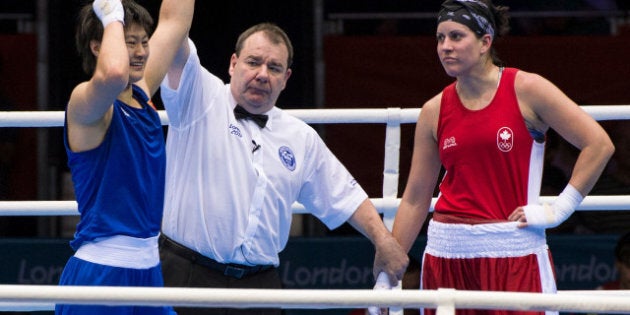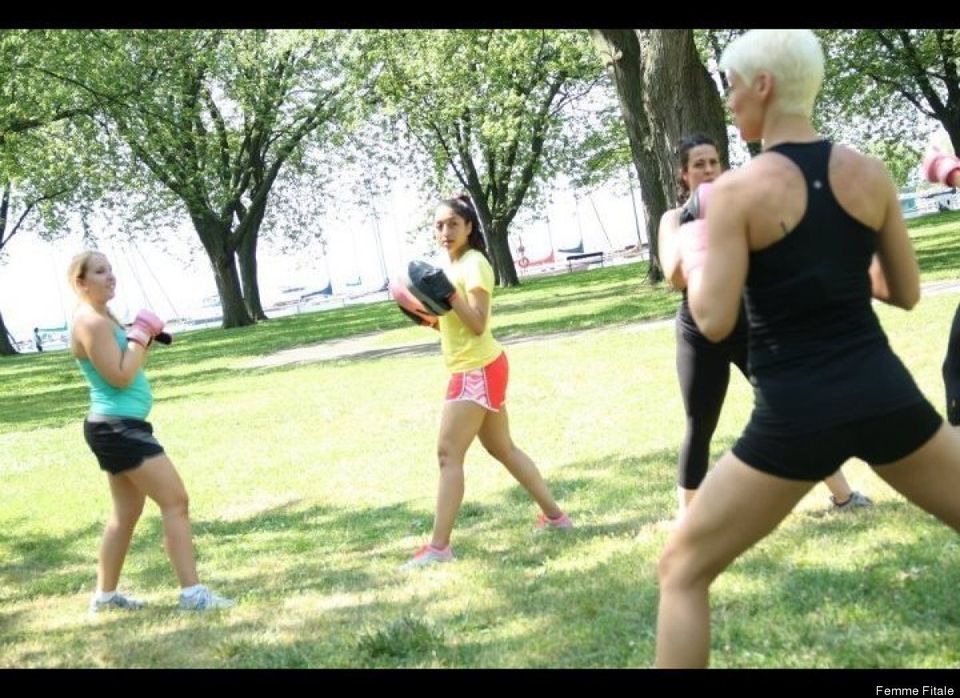
Clear away those dusty Tae Bo DVDs -- it's time for a real boxing workout.
With women's boxing showcased at the Olympics for the first time ever this year, the attention in the ring has shifted from the men to the women.
Though Canada's Mary Spencer, the medal hopeful for the sport, lost in the quarter-final match, the new sport continues to entrance, the culmination of years of fighting to be included in the competition.
And while two of the women wore skirts -- by choice, not uniform -- for their fights, there's very little stereotypically feminine about this sport, or the workout that goes into it. Women wear breast protection in addition to groin protection, and must provide a negative pregnancy before they fight. As well, women's bouts last a maximum of 10 rounds, whereas male bouts can be anywhere from four to 12.
But what actually goes into the training part of the workout? We got in touch with Sammie Kennedy, creator and CEO of Femme Fitale, a kickboxing training program that focuses on increased strength and energy, not to mention weight loss and stress reduction.
"Kickboxing is the next big thing in women’s fitness,” said Kennedy in a press release. “I believe that doing kickboxing with pad work and MMA conditioning is the perfect routine to take a woman’s exercise program up to that next level."
SEE: The moves that make up a kickboxing workout, featuring Sammie Kennedy:
Fight Stance
All moves are done from a fight stance unless otherwise indicated. Moves can be done with or without a partner holding pads, though it’s ideal to have a target to aim for!
Begin with feet together and with one leg, take two steps to the side, then two steps back. With a slight bend in the knees, plant feet firmly on the ground and maintain a tight core to stay balanced and prevent your opponent from knocking you over. Always keeps hands closed in fists and up at chin level palms facing inwards towards the sides of the jaw.
Jab
Jabs are meant for speed. Jabs are thrown from the same hand as the leading foot in your fighting stance (i.e. right leg forward and right arm jabbing). In the fight stance take a small step forward and extend your arm in a punch, first two knuckles aimed at the centre of your target. Rotate the palm on extension so that the palm is facing the ground. Switch the foot in the front position to jab with the other arm. A jab will help you gauge how far away your opponent is from you.
Works: biceps, core, back & deltoids
Cross
A cross is your power punch and the movement generates from the back leg. A cross engages the full body from the toe, up through the leg, the core and arm. Using the same arm as your back leg in your fighting stance, pivot the back ankle as if squishing something underneath the foot. Rotating the hips to bring them parallel to your opponent & engaging the oblique muscles extend the opposite arm forward. Again ensure the first two knuckles are aimed at the center of your target. Rotate the palm on extension so that the palm is facing the ground.
Works: biceps, calves, deltoids, hips & obliques
Hook
The hook utilizes the same rotation and movement as the cross. Keeping the arm at a 90 degree angle with elbow, forearm parallel to the ground at shoulder height, punch while pivoting the foot. Imagine swooping your supervillain cape in front of you to cover your face.
Works: biceps, calves, deltoids, hips & obliques
Uppercut
In a fight stance, start by lowering the body slightly by bending the knees. Engage the oblique muscles by leaning to the side with the corresponding arm bent at 90 degrees and hands clenched in fists. Punch upwards in a hook-like motion as if aiming for your opponent's chin. Be sure to pivot the same leg as the arm that is performing the hook, where your power will come from.
Works: biceps, calves, core, glutes & quads
Front Kick
Leaning backward and keeping the core tight with fists to chin, lift your back leg while pointing the toe downward and flicking the leg forward. Aim to hit your target with the top of the foot and shin (not the toe).
Works: calves, core, hip flexors, hamstrings & glutes
Roundhouse
From a fighter's stance, engage the core and bring your leg back up as one whole unit. Rotate your hips, making a semi-circle movement with the kick to hit your target. Your shin should now be pointing at your target's side. Ensure that you pivot the balancing leg 45 degrees outwards to properly engage the obliques and ensure maximum power. Similarly to the front kick, aim to hit your target with the top of the foot and shin area (not the toe).
Works: calves, core, glutes, hips, obliques & quads
Boxer Sit-Up
Laying in a supine position, keep fists to chin. Engage the core muscles lifting into a v-sit position keeping the back as straight as possible and punch from side to side engaging the obliques muscles.
Works: back, delts, lats, core & obliques
Plank With Elbows
Laying in a prone plank position, resting on the forearms with the body in a straight alignment, rotate the hips bringing the elbow straight up to contact the pad so that it's perpendicular with the ground at shoulder level. Switch sides and repeat, hitting the target with the elbow.
Works: back, core, obliques & shoulders
Duck And Weave
This move prevents you from being hit by your opponent. Come into a low squat maintaining a straight back with your weight resting on the front leg. Shift weight to the back leg when coming back up being sure to engage your obliques. Repeat from side to side.
Works: calves, core, hamstrings & quads
The Slip
Keeping a tall torso with fists at the chin and without leaning forward, engage in a slight oblique crunch moving from side to side in order to avoid being hit by your opponent.
Works: obliques and core
